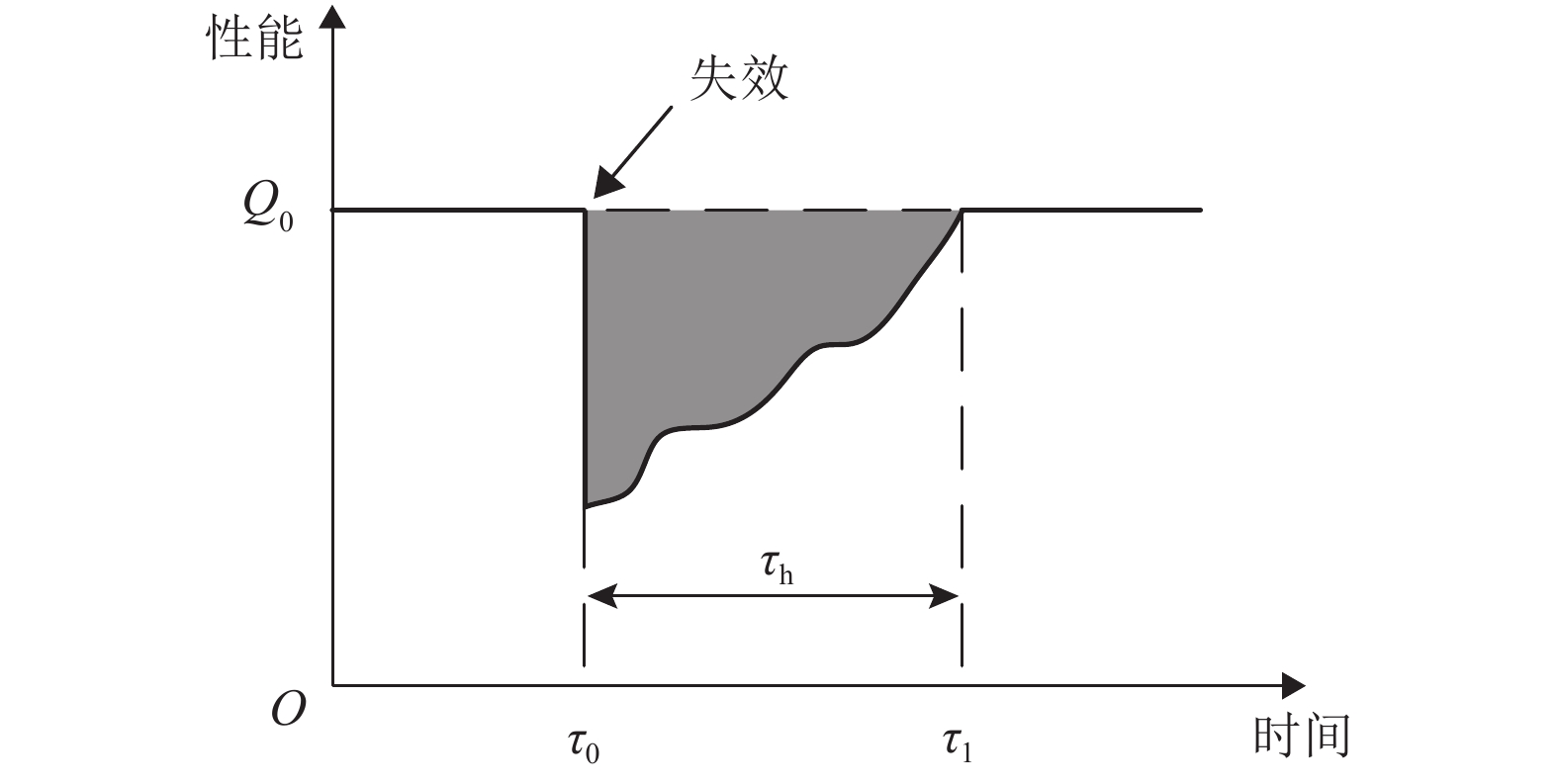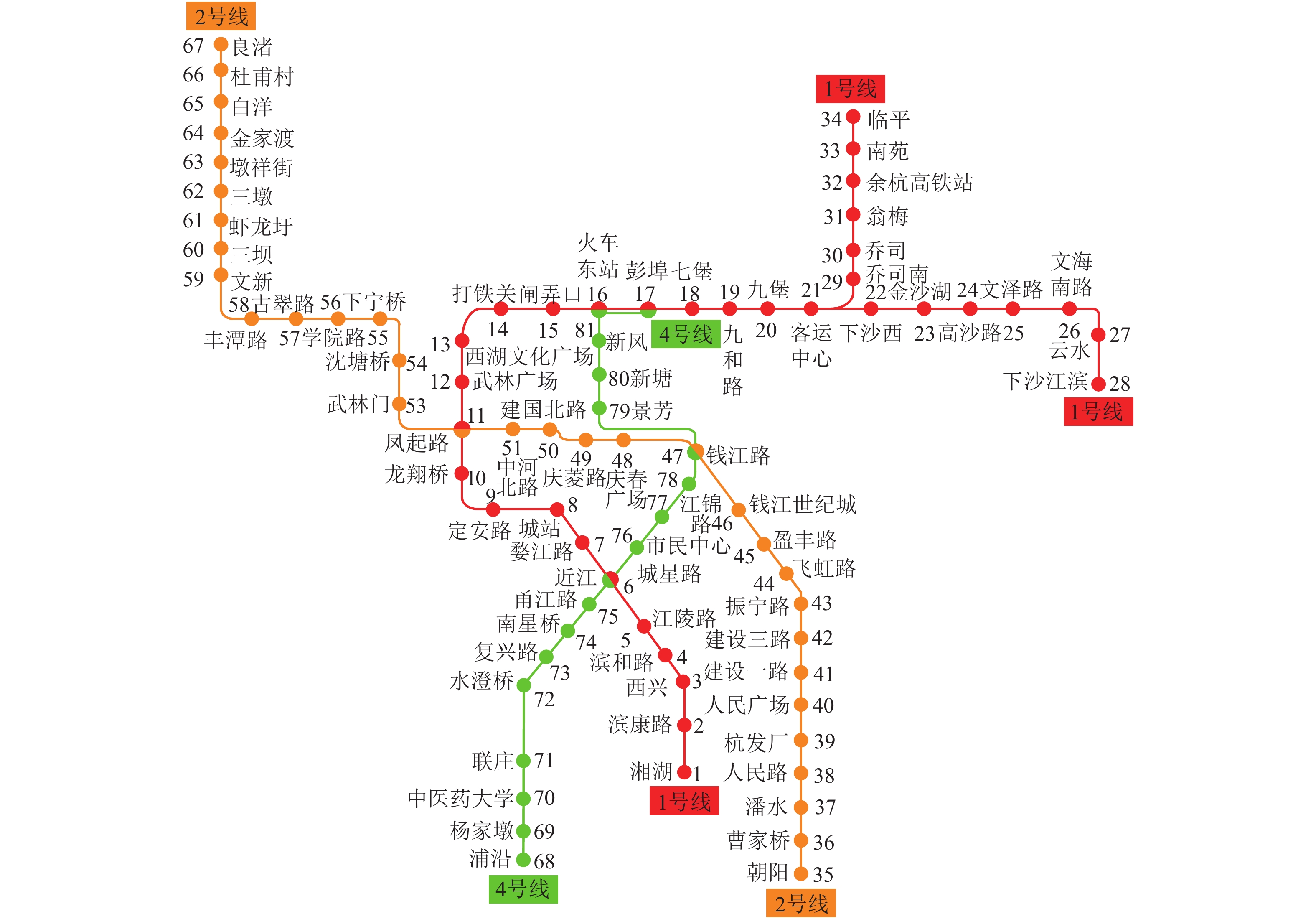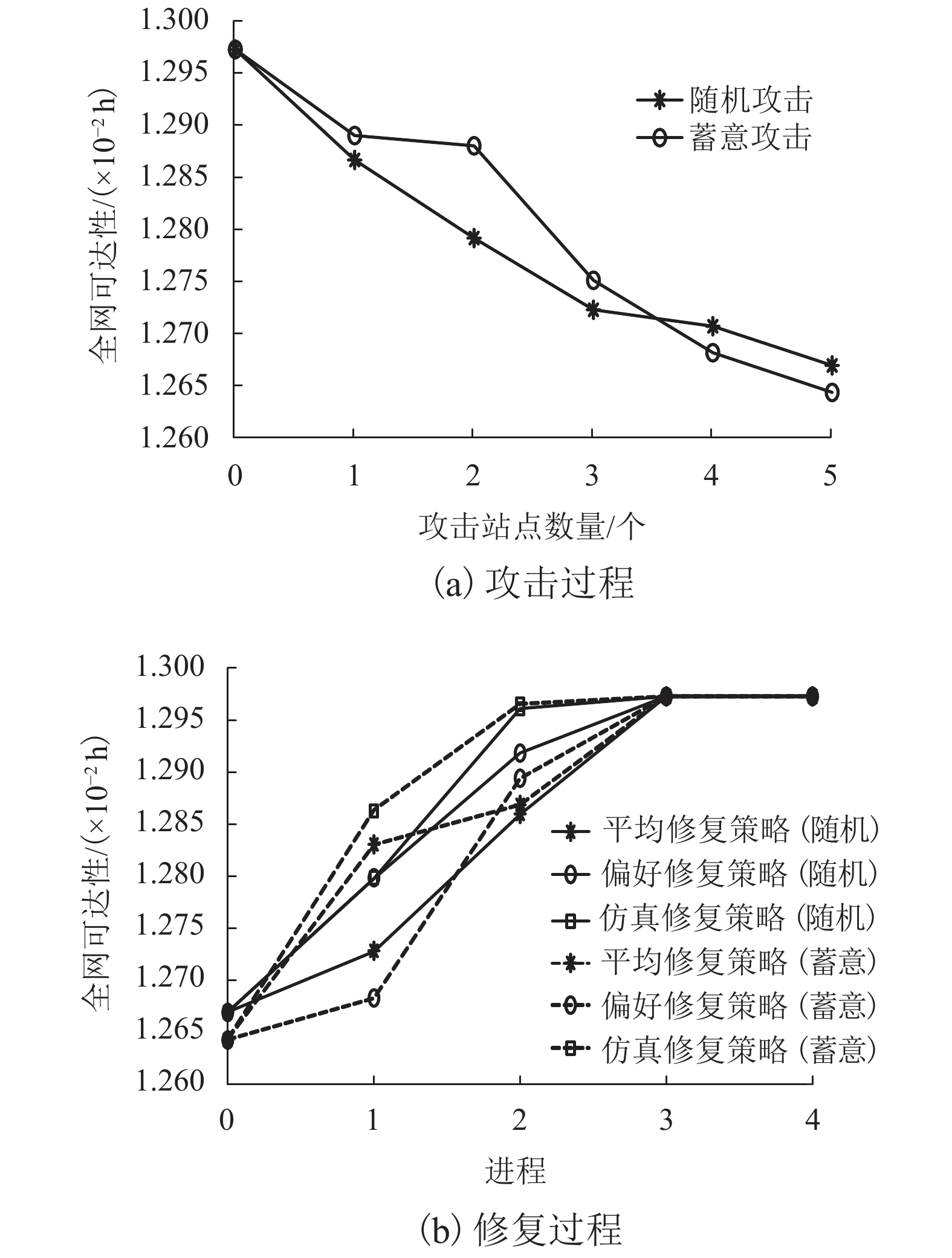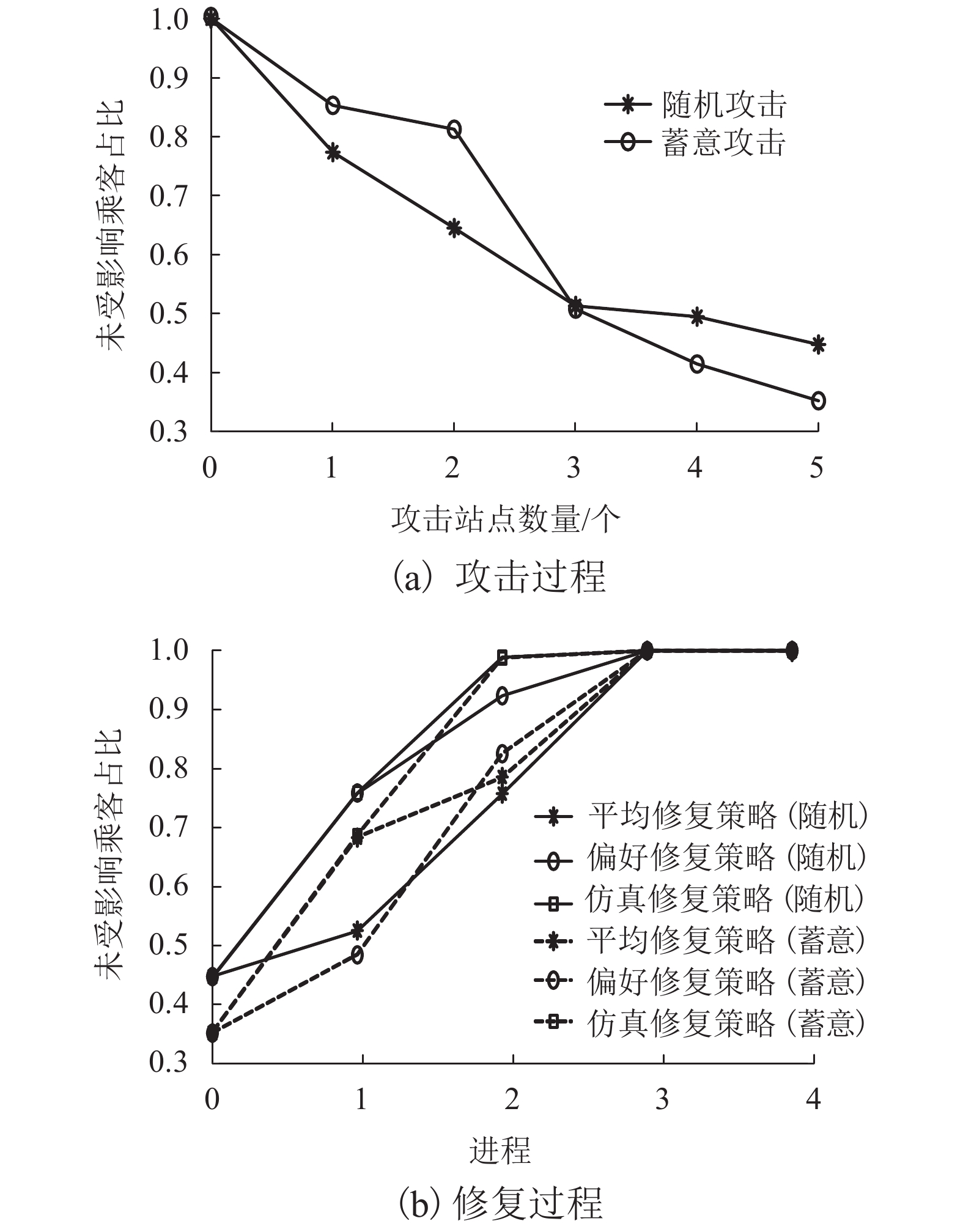Repair Strategies for Failure of Urban Rail Transit Stations
-
摘要: 为提高城市轨道交通(urban rail transit,URT)系统应对突发事件的能力,研究了URT站点在自然灾害及人为破坏情况下的修复策略. 分别运用随机攻击及蓄意攻击模拟URT站点遭受自然灾害及人为破坏的情况,结合仿真思想提出失效URT网络的仿真修复策略,运用平均修复策略、偏好修复策略及仿真修复策略实现受损URT网络的修复,结合全网可达性及未受影响乘客占比,提出全网可达性损失和全网未受影响乘客占比损失两类系统弹性损失指标用于衡量修复策略的有效性. 结果表明:蓄意攻击情况下全网可达性及未受影响乘客占比分别下降了2.54%及64.82%,高于随机攻击的2.34%及55.28%,蓄意攻击对URT网络的损害更大;修复因随机攻击而失效URT网络时,仿真修复策略的两类弹性损失指标分别为0.009及0.182,优于平均修复策略的0.012及0.305和偏好修复策略的0.010及0.197,修复因蓄意攻击而失效URT网络时,仿真修复策略的两类弹性损失指标分别为0.009及0.258,优于平均修复策略的0.012及0.312和偏好修复策略的0.014及0.354,表明仿真修复策略更适用于完成受损URT网络的修复工作;修复全程中仿真修复策略曲线的平均斜率为0.146,大于平均修复策略的0.092及偏好修复策略的0.117,表明相比于常规修复策略,仿真修复策略能达到更高的修复效率;当维修资源受限时,采用仿真修复策略能够达到最优的修复效果.Abstract: In order to improve the ability of urban rail transit (URT) systems to respond to emergencies, the effective repair strategies for URT stations under natural disasters and human attack are discussed. Firstly, the station failure caused by natural disasters and human attack are simulated by random attack and intentional attack, respectively. Secondly, the simulation repair strategy for damaged URT network is proposed. Finally, the average repair strategy, preference repair strategy and simulation repair strategy are used to repair the damaged URT network, and the effectiveness of repair strategies is measured with two categories of resiliency loss indicators: global accessibility resiliency loss and global proportion of unaffected passengers resiliency loss, which are proposed on the basis of the global accessibility and proportion of unaffected passengers. The results show that the global accessibility and proportion of unaffected passengers decrease by 2.54% and 64.82% in case of intentional attack, which are higher than 2.34% and 55.28% of random attack. Intentional attack is more harmful to the URT network than random attack. When the damaged URT network caused by random attack is repaired, the resiliency loss indicators of the simulation repair strategy are 0.009 and 0.182, which are better than 0.012 and 0.305 for average repair strategy and 0.010 and 0.197 for preference repair strategy; when the damaged URT network caused by intentional attack is repaired, the resiliency loss indicators of the simulation repair strategy are 0.009 and 0.258, which are better than 0.012 and 0.312 for average repair strategy and 0.014 and 0.354 for preference repair strategy. It indicates that the simulation repair strategy is more suitable for repairing the damaged URT network. The average slope of the simulation repair strategy curve is 0.146, which are higher than 0.092 for average repair strategy and 0.117 for preference repair strategy. Compared with conventional repair strategies, the simulation repair strategy has higher repair efficiency. Using simulation repair strategy can achieve optimal result when the repair resources are limited.
-
Key words:
- urban traffic /
- station failure /
- repair strategy /
- simulation repair strategy /
- resiliency loss
-
表 1 随机及蓄意攻击站点
Table 1. Stations under random and intentional attacks
随机攻击 蓄意攻击 站点编号 站点名称 站点编号 站点名称 21 客运中心站 6 近江站 41 建设一路站 10 龙翔桥站 57 古翠路站 11 凤起路站 61 虾龙圩站 12 武林广场站 72 水澄桥站 47 钱江路站 表 2 不同修复策略修复顺序
Table 2. Repair sequence of different repair strategies
策略 随机攻击 蓄意攻击 平均修复 61,72 | 41,57 | 21 11,47 | 10,12 | 6 偏好修复 21,57 | 61,72 | 41 47,11 | 10,12 | 6 仿真修复 21,57 | 41,61 | 72 6,47 | 11,12 | 10 表 3 不同修复策略的杭州地铁网络弹性损失
Table 3. Resilience loss of Hangzhou metro network using different repair strategies
指标 随机攻击 蓄意攻击 不修复 平均修复 偏好修复 仿真修复 不修复 平均修复 偏好修复 仿真修复 ${R_G}$ 0.019 0.012 0.010 0.009 0.023 0.012 0.014 0.009 ${R_U}$ 0.438 0.305 0.197 0.182 0.601 0.312 0.354 0.258 注:不修复表示对受损网络不采取修复策略. 表 4 3种修复策略修复结果(考虑维修资源限制)
Table 4. Results of three different repair strategies (with repair resource limits)
进程 平均修复策略 偏好修复策略 仿真修复策略 随机失效 蓄意失效 随机失效 蓄意失效 随机失效 蓄意失效 $100G/{\rm{h}}$ $U$ $100G/{\rm{h}}$ $U$ $100G/{\rm{h}}$ $U$ $100G/{\rm{h}}$ $U$ $100G/{\rm{h}}$ $U$ $100G/{\rm{h}}$ $U$ 0 1.269 0.499 1.263 0.314 1.269 0.499 1.263 0.314 1.269 0.499 1.263 0.314 1 1.276 0.626 1.273 0.526 1.281 0.782 1.267 0.454 1.281 0.782 1.286 0.668 2 1.291 0.831 1.286 0.772 1.291 0.931 1.289 0.816 1.291 0.931 1.300 0.951 注:$100G$表示放大 100 倍后的全网可达性. -
中国城市轨道交通协会. 城市轨道交通2018年度统计和分析报告[J]. 城市轨道交通,2019(4): 16-34.CAMET. Urban rail transit 2018 annual statistics and analysis report[J]. China Metros, 2019(4): 16-34. 王正武,彭烁,黄中祥,等. 城市道路交通网络级联失效的灾害蔓延动力学模型[J]. 安全与环境学报,2014,14(3): 1-4.WANG Zhengwu, PENG Shuo, HUANG Zhongxiang,et al. Disaster sprawling dynamics model for the cascading failure in urban road traffic network[J]. Journal of Safety and Environment, 2014, 14(3): 1-4. 程杰,刘杰,唐智慧. 城市道路网络修复策略研究[J]. 中国安全科学学报,2012,22(9): 114-120.CHENG Jie, LIU Jie, TANG Zhihui. Research on repair strategies of urban road network[J]. China Safety Science Journal, 2012, 22(9): 114-120. 李成兵,李奉孝,王璐瑶. 城市群客运交通网络可靠性修复仿真[J]. 西南交通大学学报,2019,54(2): 388-394,401.LI Chengbing, LI Fengxiao, WANG Luyao. Simulation of passenger traffic network reliability restoration in urban agglomeration[J]. Journal of Southwest Jiaotong University, 2019, 54(2): 388-394,401. AKSU D T, OZDAMAR L. A mathematical model for post-disaster road restoration:enabling accessibility and evacuation[J]. Transportation Research Part E:Logistics and Transportation Review, 2014, 61: 56-67. doi: 10.1016/j.tre.2013.10.009 CHANG S E. Transportation planning for disasters:an accessibility approach[J]. Environment and Planning A, 2003, 35(6): 1051-1072. doi: 10.1068/a35195 STARITA S, SCAPARRA M P. Optimizing dynamic investment decisions for railway systems protection[J]. European Journal of Operational Research, 2016, 248(2): 543-557. doi: 10.1016/j.ejor.2015.07.025 HONG L, OUYANG M, PEETA S, et al. Vulnerability assessment and mitigation for the Chinese railway system under floods[J]. Reliability Engineering & System Safety, 2015, 137: 58-68. PEREA F, PUERTO J. Revisiting a game theoretic framework for the robust railway network design against intentional attacks[J]. European Journal of Operational Research, 2013, 226(2): 286-292. doi: 10.1016/j.ejor.2012.11.015 宗刚,陈先婷. 突发事件对城市轨道交通网络的影响研究−以北京市为例[J]. 中国安全科学学报,2015,25(8): 106-110.ZONG Gang, CHEN Xianting. Effect of emergency on urban railway transit network:a case study of Beijing[J]. China Safety Science Journal, 2015, 25(8): 106-110. LI M, WANG H, WANG H. Resilience assessment and optimization for urban rail transit networks:a case study of Beijing subway network[J]. IEEE Access, 2019, 7: 71221-71234. doi: 10.1109/ACCESS.2019.2919105 ZHANG D, DU F, HUANG H, et al. Resiliency assessment of urban rail transit networks:Shanghai metro as an example[J]. Safety Science, 2018, 106: 230-243. doi: 10.1016/j.ssci.2018.03.023 SAADAT Y, ZHANG Y, ZHANG D, et al. Post-failure recovery strategies for metrorail transit networks with Washington D. C. as a case study[C]//Proceedings of the 2018 International Mechanical Engineering Congress and Exposition. Pittsburgh: ASME, 2018: 87471.1-87471.14. 池丽平. 遭袭复杂网络的修复策略与关联特征研究[D]. 武汉: 华中师范大学, 2006. 党亚茹,李雪娇. 七大空管区域复杂网络特征对比与抗毁性分析[J]. 复杂系统与复杂性科学,2015,12(3): 19-26.DANG Yaru, LI Xuejiao. Characteristics contrast and invulnerability analysis of seven regional air traffic control complex network[J]. Complex Systems and Complexity Science, 2015, 12(3): 19-26. 张豫翔,吴明功,王肖戎,等. 航空运输网络失效修复优化策略研究[J]. 计算机仿真,2017,34(9): 88-93. doi: 10.3969/j.issn.1006-9348.2017.09.019ZHANG Yuxiang, WU Minggong, WANG Xiaorong, et al. Study on repair optimization strategy for air transportation network failure[J]. Computer Simulation, 2017, 34(9): 88-93. doi: 10.3969/j.issn.1006-9348.2017.09.019 WARDMAN M, WHELAN G. Twenty years of rail crowding valuation studies:evidence and lessons from British experience[J]. Transport Reviews, 2011, 31(3): 379-398. doi: 10.1080/01441647.2010.519127 黄一华. 城市轨道交通客流分配模型与算法的研究[D]. 北京: 北京交通大学, 2010. LIU H X, HE X, HE B. Method of successive weighted averages (MSWA) and self-regulated averaging schemes for solving stochastic user equilibrium problem[J]. Networks and Spatial Economics, 2009, 9(4): 485-503. doi: 10.1007/s11067-007-9023-x 刘朝阳,吕永波,刘步实,等. 城市轨道交通运输网络级联失效抗毁性研究[J]. 交通运输系统工程与信息,2018,18(5): 82-87.LIU Chaoyang, LÜ Yongbo, LIU Bushi, et al. Cascading failure resistance of urban rail transit network[J]. Journal of Transportation Systems Engineering and Information Technology, 2018, 18(5): 82-87. BRUNEAU M, CHANG S E, EGUCHI R T, et al. A framework to quantitatively assess and enhance the seismic resilience of communities[J]. Earthquake Spectra, 2003, 19(4): 733-752. doi: 10.1193/1.1623497 -






 下载:
下载:




